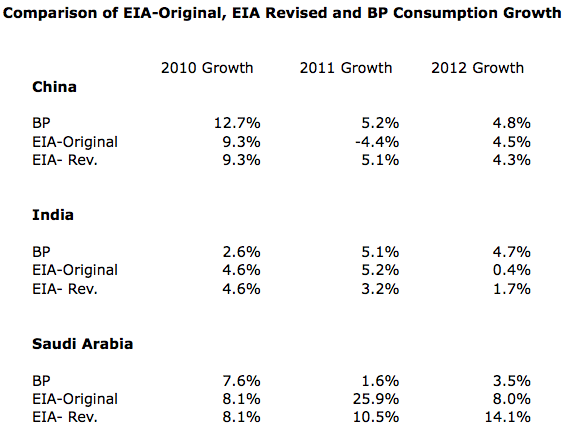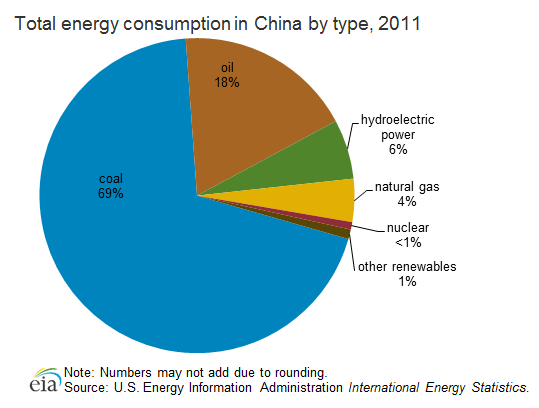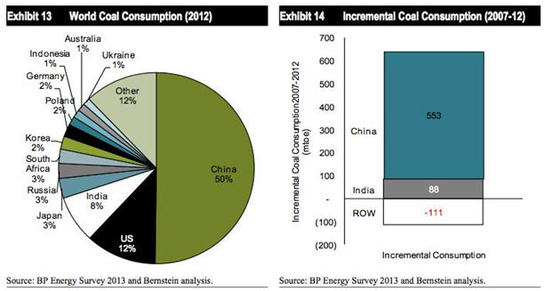China Pollution Cause #3: Resource Consumption:
While gasoline prices for consumers remain fixed in China, the fuel being used by the factories that produce all the products is still being purchased at market prices. As the prices of oil and electricity continue to rise, Chinese industrial plants have no choice but to turn to the cheaper, yet much more environmentally harmful, coal. The demand for Chinese-produced goods will be too much for Chinese factories to switch back to oil. The byproducts of the coal-burning plants add much more air pollution than you would see from another form of energy.[1]
< Figure 3.0"Based on revised EIA data, it appears that at current high oil prices shown in figure 3.1 and 3.2 below, oil demand in the United States and Europe is being reduced. There are some indications that oil demand in China and India are flattening shown in figure 3.1 and 3.2, but these are preliminary. For those who are wondering how high oil prices need to be, to be “too high,” the answer is, “We are already there, for the United States and Europe. We are getting there for China and India. In fact, continued high oil prices are a big reason behind the recessionary forces we are now seeing around the world.”[2]
China and India, like the United States and most of Europe, are oil importers. Over time, we should expect high oil prices to have an impact on all importers. While the original EIA data suggested that China and India were affected in 2011 and 2012, the impact is much more muted using revised data. |
From both figures shown above, oil price has increased particularly China. China went from around $40 to $110 whereas India went from $65 to $105. One thing to note is that oil price has risen very steadily with no notable drops in price. On the other hand, we can see that at the $100-$110 per barrel price mark, there appears to be a flattening in per capita consumption, especially India.
'China's oil consumption growth has eased after a high of 14% in 2009, reflecting the effects of the most recent global financial and economic downturn. ' [3]
'China's oil consumption growth has eased after a high of 14% in 2009, reflecting the effects of the most recent global financial and economic downturn. ' [3]
|
Figure 3.3 shows:
Coal served as a vast majority (69%) of China's total energy consumption in 2011. Oil was the second largest source, taking up 18% of China's total energy consumption. The other sources show signs of China's efforts to diversify into other energy source such as hydroelectric sources (6%), natural gas (4%), nuclear power (less than 1%), and other renewables (1%). However, this only adds up to 12% of China's total energy consumption which is a relatively small share. Theoretically speaking, China is around 4 times as reliant on coal than oil or other energy sources. According to EIA, the "absolute coal consumption is expected to increase by over 50% during 2020 and 2040 forecast period, reflecting the large growth in total energy consumption." [3] This high coal consumption percentage is the exact reason for China being the world's leading energy-related Carbon Dioxide emitter. In 2011, China emitted 8,7715 million metric tons of carbon dioxide. |
References:
[1] James Ellis. (2008). Chinese Pollution. Available: http://dailyreckoning.com/free-reports/chinese-pollution/. Last accessed 15th Oct 2014.
[2] Gail Tverberg. (2013). High Oil Prices are Starting to Affect China and India. Available: http://ourfiniteworld.com/2013/06/07/high-oil-prices-are-starting-to-affect-china-and-india/. Last accessed 20th Oct 2014.
[3] EIA. (2014). CHINA. Available: http://www.eia.gov/countries/cab.cfm?fips=ch. Last accessed 20th Oct 2014.
[4] Eric Larson. (2014). China’s Growing Coal Use Is World’s Growing Problem. Available: http://www.climatecentral.org/blogs/chinas-growing-coal-use-is-worlds-growing-problem-16999. Last accessed 21th Oct 2014.
[5] Claudia Assis. (2013). From China coal to California cool? The world slowly shuns fossil fuels. Available: http://blogs.marketwatch.com/energy-ticker/2013/10/02/from-china-coal-to-california-cool-the-world-slowly-shuns-fossil-fuels/. Last accessed 20th Oct 2014.
[2] Gail Tverberg. (2013). High Oil Prices are Starting to Affect China and India. Available: http://ourfiniteworld.com/2013/06/07/high-oil-prices-are-starting-to-affect-china-and-india/. Last accessed 20th Oct 2014.
[3] EIA. (2014). CHINA. Available: http://www.eia.gov/countries/cab.cfm?fips=ch. Last accessed 20th Oct 2014.
[4] Eric Larson. (2014). China’s Growing Coal Use Is World’s Growing Problem. Available: http://www.climatecentral.org/blogs/chinas-growing-coal-use-is-worlds-growing-problem-16999. Last accessed 21th Oct 2014.
[5] Claudia Assis. (2013). From China coal to California cool? The world slowly shuns fossil fuels. Available: http://blogs.marketwatch.com/energy-ticker/2013/10/02/from-china-coal-to-california-cool-the-world-slowly-shuns-fossil-fuels/. Last accessed 20th Oct 2014.






